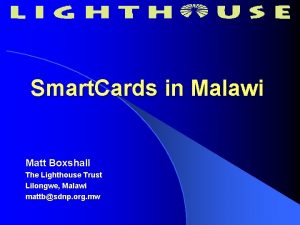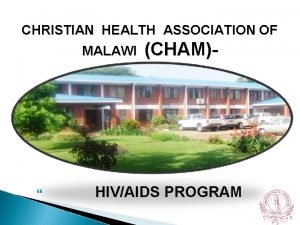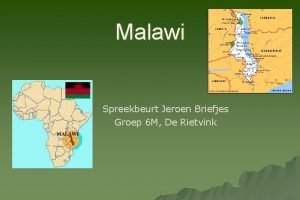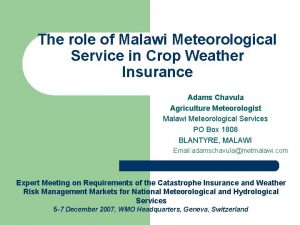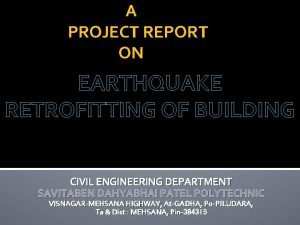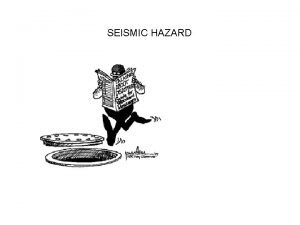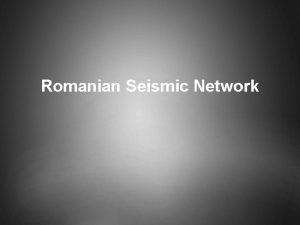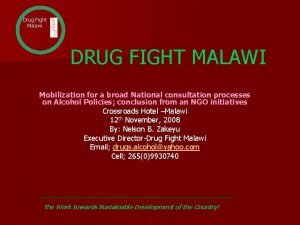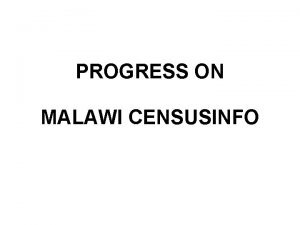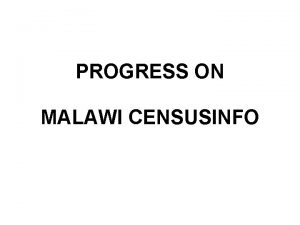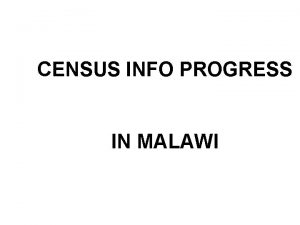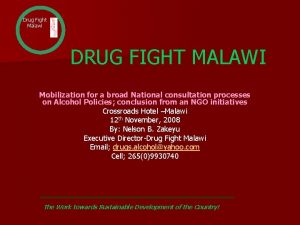REPORT ON MALAWI SEISMIC NETWORK Chindandali P Lunda












- Slides: 12

REPORT ON MALAWI SEISMIC NETWORK Chindandali P. , Lunda J. , Mphepo F. Geological Survey Department of Malawi Managing Data from Seismic Networks August 20 -26, 2017, Pretoria, South Africa

CONTENTS Introduction Objectives Seismic Network Real-Time Monitoring Data Availability Seismicity Collaborations Summary/Conclusion

INTRODUCTION Malawi is located on the western branch of the East African Rift System –EARS (Figure 1). It is a seismically active belt mostly characterized by shallow earthquakes Malawi Figure 1: The East African Rift System

OBJECTIVES Determination of earthquake locations Seismic hazards research & monitoring Mapping of suspected faults Research on the interior of the earth Dissemination of earthquake information to general public Advising Government and civil society on matters relating to earthquakes Public awareness

SEISMIC NETWORK Instrumental seismological observation in Malawi dates back to 1962 Currently, 6 broadband stations are operational. Four stations are co-located with GPS stations Africa. Array operates two seismic stations in Zomba and Mzuzu, co-located with GPS and weather Stations. Figure 2: Seismic Stations in Malawi (Basemap: Ryan et. Al. , 2009)

SEISMIC NETWORK • Equipment: Ø RT 130 -01/B Data Loggers by Ref. Tek Ø 151 -120 A Seismometers by Ref. Tek (Figure 3) Ø Trillium Compact broadband seismometers Ø Trimble Net. RS/Net. R 9 GPS system Installation for GPS antenna. Photo courtesy of UNAVCO RT 130 -B Data Logger 151 -120 A Sensor. Phot courtesy of Ref. Tek RT 130 -01 Data Logger Net. R 9 GPS system. Compact Trillium Sensor http: //www. trimble. com/ http: //www. nanometrics. ca

REAL-TIME MONITORING Currently, only ZOMB is streaming data to IRIS in realtime under Africa. Array –AF. (Figure 4) Dedicated IP address We intend to establish remote access to a few more stations in future through GSM Figure 4: Real-time data streaming to IRIS from ZOMB using RTP 2 RTPD

DATA AVAILABILITY SINCE 2010

SEISMICITY Small-to-moderate earthquakes occur both from within the country and from neighbouring countries Spatial distribution shows northern Malawi as highly active followed by the centre whereas the south is sparsely distributed Seismicity picks up again further south of the country into Mozambique (Figure 5). Figure 5: Seismicity of Malawi

COLLABORATIONS Geological Survey Department of Malawi Polytechnic- University of Malawi Mzuzu University Chancellor College- University of Malawi University of Science and Technology Malawi Institute of Engineers Catholic University CTBTO IRIS Goetz Observatory, Bulawayo ESARSWG Lamont-Doherty Institute, Columbia University, USA etc.

SUMMARY/CONCLUSION Generally, spatial distribution of earthquakes concentrates along the rift structures. Northern Malawi is highly active followed by the centre. The southern part is sparsely distributed before it picks up again in the Mozambique area Recent events in the country needs consistent monitoring and densification of stations. 5 stations will be reinstalled soon To add a few more stations on Open Data Policy as part of FSDN effort

Thank you for listening

